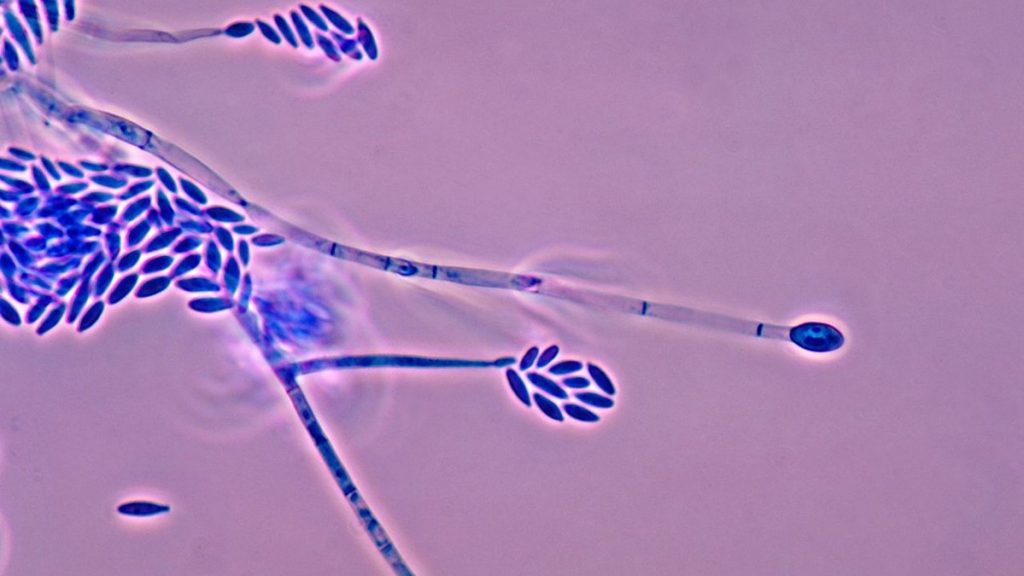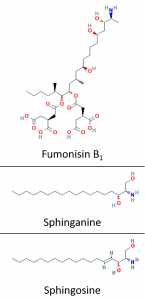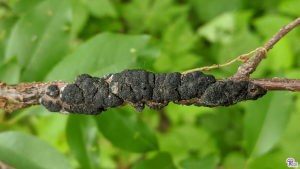#204: Fumonisins

Fusarium verticillioides (above) and F. proliferatum are two of the most common fungal pathogens of maize. These fungi produce the fumonisin toxins. Photo: CDC via Wikimedia.
Humans have very little to worry about from fumonisins, mycotoxins produced by Fusarium fungi that cause Fusarium ear rot disease of corn (maize). The toxins are linked with esophageal cancer, but scientists cannot prove that they cause cancer. However, fumonisins are a major problem for horses and pigs. In horses, the toxins cause liquefaction of the brain tissue, while in pigs they cause the lungs to fill with water.1
Sources
Fumonisins are produced by a few species of Fusarium, but mainly by Fusarium verticillioides (formerly Fusarium moniliforme) and Fusarium proliferatum. These fungi infect numerous crops, but corn is most susceptible.1 In fact, these fungi are the most common pathogens of maize. Maize is a staple food for many people (and domestic animals), so people are most likely to be exposed to fumonisins through maize products.2 Fumonisins are tolerant of high temperatures, so they are for the most part left intact while preparing corn-based foods.2,3
Fusarium species produce fumonisins as part of the disease process. Fumonisins are toxic to plant cells, so producing them helps the fungi infect plants.4 In corn, F. verticillioides and F. proliferatum cause a disease called “Fusarium ear rot.”1,5 The fungi infect the plants when they are young or when the ears are beginning to form, gaining entry through insect damage. When the ears near maturity, the fungi begin producing visible symptoms. Infected kernels are brownish to pinkish to whitish and often have white streaks called “star bursts.” The star bursts indicate where the fungus is growing just underneath the kernel’s seed coat. Fusarium ear rot is most prolific in years with long dry periods followed by rain.2,4

Fumonisin B1 resembles sphinganine and sphingosine, which are precursors to sphingolipids. As a result, Fumonisin B1 blocks sphingolipid synthesis. Photos: PubChem (1, 2, 3).
Structure and Mechanism
There are at least 28 types of fumonisins, divided into four series designated A, B, C, and P.3 In general, fumonisins have a hydrocarbon tail (the zig-zag line in the picture) and a polar head (the area with lots of O’s in the picture). Fumonisins differ from one another based on the types of modifications the head and tail have.4,6 The most potent of these compounds are fumonisin B1 (FB1) and fumonisin B2 (FB2).2,3,7,8 Its structure is very similar to those of sphingosine and sphinganine. Both of those molecules are important building blocks for a class of molecules called “sphingolipids.” Sphingolipids have a variety of rolls in animal cells, from regulating growth to adjusting cell signaling pathways.2,3,7
Scientists believe that B fumonisins – especially FB1 – damage cells primarily by interfering with sphingolipid production. This has not been conclusively proven, but most of the current evidence seems to support this theory. Additionally, there are probably other mechanisms involved that have not been very well-studied. Fumonisins can inhibit sphingolipid production because they are structurally similar to sphingosine and sphinganine.2,3 Presumably, this allows fumonisin to bind to the enzymes responsible for converting sphingosine and sphinganine into sphingolipids, which prevents those enzymes from functioning properly. The result is that sphingosine and especially sphinganine accumulate in the cell and no new sphingolipids are produced. Cell death follows these changes because high concentrations of sphingosine and sphinganine are toxic and because sphingolipids are required for proper cell growth and communication.2
Human Impacts
The human impacts of fumonisins are not very well understood. FB1 is associated with cancer of the esophagus in Africa, Iran, northern Italy, and southeastern United States. Additionally, FB1 is linked to liver cancer in some parts of China. However, scientists have been unable to conclusively prove that FB1 causes cancer in the laboratory.2,3 On top of that, the mechanism by which FB1 causes cancer is unknown. Because of this, the International Agency for Research on Cancer classifies FB1 as “probably carcinogenic.”3 Fumonisins may also cause neural tube defects in fetuses.1 The U.S. Food and Drug Administration (FDA) recommends that total fumonisin concentration in food be less than 2-4 parts per million (ppm), depending on the type of food.9 In normal years, corn often contains 1-3ppm of fumonisins, so these standards are usually easy for food producers to follow.8
Animal Impacts
Fumonisins are most problematic for domestic animals. Many animals get sick or die from exposure to fumonisins, but horses and pigs are especially susceptible. In horses, fumonisins cause a disease called “equine leukoencephalomalacia.” In equine leukoencephalomalacia, the white matter of the brain dies and liquefies, eventually causing death. Symptoms of this disease include drowsiness, blindness, paralysis of the upper throat, circling, staggering, apathy, and lying down.1,8 Horses may also suffer liver damage, but brain damage is clearly the more significant problem. The disease is fatal except in very rare cases. Death usually occurs 1-2 days after the onset of symptoms, but may happen anywhere from several hours to a few weeks. Leukoencephalomalacia is triggered after several weeks of eating feed with fumonisin concentrations as low as 8-10ppm. In years with high Fusarium infection rates, fumonisin concentration in corn grain can reach 20-100ppm, well over the amount required to trigger disease in horses.8 The FDA recommends a maximum fumonisin concentration of 5ppm in feed intended for horses (in corn products, which should comprise no more than 20% of the animals’ diets) – only slightly more than the limit for humans.9
Pigs suffer an entirely different set of symptoms as a result of fumonisin exposure. Those animals suffer “porcine pulmonary edema” (PPE), a disease where the lungs fill with water.1,8 PPE is usually accompanied by “hydrothorax,” where fluids accumulate in the thin space around the lungs. These conditions are believed to occur because the toxin upsets the balance between the lungs and circulatory system. Symptoms of PPE include difficulty breathing, bluish coloration of mucous membranes, weakness, and lying down.8 One similarity that pigs have to horses is that pigs can suffer liver damage after long-term exposure to non-lethal levels of fumonisins. This can result in reduced growth and yellowing of the eyes, among other symptoms.1,8 Over half of pigs with PPE symptoms die, usually within a day of showing the first signs of the disease. PPE is triggered by exposure to fumonisin concentrations of over 100ppm for 3-6 days.8 The FDA recommends that pig feed contain no more than 20ppm of fumonisins (in corn products, which should comprise no more than 50% of the animals’ diets).9
Other domestic animals have a greater tolerance for fumonisins and milder symptoms. Cows and sheep develop symptoms at concentrations between 150ppm and 200ppm, while poultry are tolerant of levels 200-400ppm or greater. In these animals, the primary symptoms of fumonisin toxicity are decreased appetite and weight loss.8
Solutions
F. verticillioides and F. proliferatum are very difficult to manage in maize. Because the fungi often infect plants early, symptoms do not appear until the fungi are already well established. Fungicides are ineffective against these fungi, so there is very little that can be done once you notice an infection. The best method for dealing with fumonisins is to harvest diseased corn fields as early. The fungi do not grow when moisture in their substrate is lower than 17%, so harvesting the maize early will prevent the fungi from producing more fumonisins when it rains. Harvested corn should be stored at less than 15% humidity to prevent more fungal growth. Of course, this does not reduce fumonisin concentration, it simply prevents it from increasing.5
In the edible parts of maize, fumonisins are found in their highest concentrations in kernels that appear small or damaged. Removing the diseased kernels helps lower fumonisin concentrations. Unfortunately, this may not be possible if the corn is mixed in with another feed or if it is ground.8
Currently, the best way to prevent Fusarium ear rot is to prevent insect damage to crops. The fungi often gain entry to plant tissues through holes made by insects, so effective pest control also reduces rates of fungal infection. One of the most effective methods of pest control in maize is using genetically modified Bt corn. This may not be an ideal solution for many, but it does reduce the incidence of Fusarium ear rot. Corn hybrids that are somewhat resistant to Fusarium infection are also available.5
Do not use information in this post to self-diagnose or self-treat a medical complaint. Always consult a licensed medical doctor for proper diagnosis and treatment of a health issue.
See Further:
https://www.apsnet.org/edcenter/intropp/topics/Mycotoxins/Pages/Fumonisins.aspx
http://www.merckvetmanual.com/toxicology/mycotoxicoses/fumonisin-toxicosis
https://www.ncbi.nlm.nih.gov/pmc/articles/PMC2635619/ (scientific paper)
http://www.who.int/ipcs/publications/ehc/en/ehc_219.pdf (very long but thorough)
Citations
- Schmale III, D. G. & Munkvold, G. P. Mycotoxins in Crops: A Threat to Human and Domestic Animal Health: Fumonisins. American Phytopathological Society Available at: https://www.apsnet.org/edcenter/intropp/topics/Mycotoxins/Pages/Fumonisins.aspx. (Accessed: 1st December 2017)
- Marasas, W. F. O., Miller, J. D., Riley, R. T. & Visconti, A. Fumonisin B1. (Inter-Organization Programme for the Sound Management of Chemicals, 2000).
- Yazar, S. & Omurtag, G. Z. Fumonisins, Trichothecenes and Zearalenone in Cereals. Int J Mol Sci 9, 2062–2090 (2008).
- Lamprecht, S. C. et al. Phytotoxicity of Fumonisins and TA-Toxin to Corn and Tomato. Phytopathology 84, 383–391 (1994).
- Woloshuk, C. & Wise, K. Diseases of Corn: Fusarium Ear Rot. (2014).
- Fumonisin B1. PubChem Available at: https://pubchem.ncbi.nlm.nih.gov/compound/14077784. (Accessed: 1st December 2017)
- Stockmann-Juvala, H. & Savolainen, K. A review of the toxic effects and mechanisms of action of fumonisin B1. Hum Exp Toxicol 27, 799–809 (2008).
- Osweiler, G. D. Fumonisin Toxicosis. Merck Veterinary Manual Available at: http://www.merckvetmanual.com/toxicology/mycotoxicoses/fumonisin-toxicosis. (Accessed: 1st December 2017)
- Guidance for Industry: Fumonisin Levels in Human Foods and Animal Feeds. U.S. Food & Drug Administration (2001). Available at: https://www.fda.gov/RegulatoryInformation/Guidances/ucm109231.htm. (Accessed: 1st December 2017)







![#011: Characteristics of Kingdom Fungi [Archived]](https://www.fungusfactfriday.com/wp-content/themes/hueman/assets/front/img/thumb-small-empty.png)


